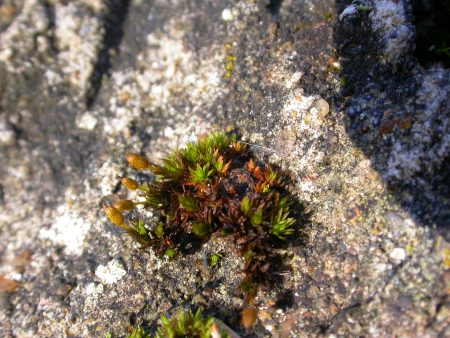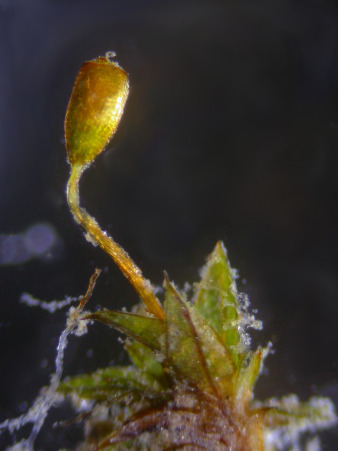BBS SE meeting, 26 November 2017
The area around Battle in Sussex has been little recorded in the past, so was an ideal target for a field meeting. Francis Rose had visited the abbey at the end of September 1993 and the 13 species recorded in the database from that visit included Eucladium verticillatum, Grimmia trichophylla (“on precinct wall”) and Leucodon sciuroides (“locally abundant”). Other than that, there was only a handful of other records, so there was certainly potential for many new finds.
Nine of us gathered in gorgeous November sunshine and largely ignored the fact that it wasn’t actually that warm; after all, it’s not every day you get to search for bryophytes on and around the most famous 1000-year-old battlefield site in the country. The site itself is now managed by English Heritage and is 11 miles from Pevensey where the Norman army landed, and about 6 miles north of Hastings.
Once we were on the sunny side of the fourteenth century gatehouse the search could begin, and though the greater part of the medieval walls were rather clean, various green patches were lurking at their bases, and in among the Tortulas was a little Gyroweisia tenuis and Fissidens gracilifolius. This was also a good opportunity to introduce the newcomers to several of the more common species in the vicinity.
Attention then turned to the adjacent precinct wall. Pete Howarth found Bryoerythrophyllum recurvirostrum and a small patch of Orthotrichum anomalum, and two non-fruiting patches of Grimmia looked promising for G. trichophylla, but turned out to be G. pulvinata instead.

Orthotrichum anomalum
Still only a few yards from the gatehouse, the tiny Microbryum davallianum was fruiting on some otherwise bare soil, and small quantities of the epiphytic Orthotrichum pulchellum and Syntrichia laevipila were located near the children’s playground.

Microbryum davallianum
We then migrated to the meadows to the east of the site, which were home to many common grassland species, as well as numerous anthills. These turned out to have an abundance of colonising mosses, primarily Ceratodon purpureus, but also Bryum subapiculatum, B. rubens, B. dichotomum, Fissidens viridulus, and the star of the meeting, a somewhat entire-leaved Acaulon muticum, subsequently confirmed by Tom. It was remarkable how the anthills were rich islands of diversity, contrasting with their surrounding flora.

Acaulon muticum
After lunch we located a small stream, in and around which several new species were uncovered. These included Metzgeria consanguinea and M. violacea on epiphyte-rich fallen Ash trees crossing the stream, together with Brachythecium rivulare, Chiloscyphus polyanthos and Plagiothecium denticulatum.
Now turning back towards the abbey and heading up towards the Saxon lines we checked out the Victorian pond. In addition to several acid woodland species we were pleased to find a small patch of Riccia fluitans on the muddy edge of the water. This is a decidedly uncommon species in the Weald, so was a fine addition to the site list.
Finally reaching the abbey ruins themselves, the remains of the latrines harboured a nice range of small acrocarps, including Zygodon viridissimus doing well on the damp, shady mortar, some Didymodon rigidulus, Pseudocrossidium revolutum and yet more Gyroweisia tenuis.
Then, as we looped back towards the gatehouse, Sue found Eucladium verticillatum in the nineteenth century ice house, bringing the total for our visit to 82 species. Unfortunately the target species weren’t re-found, but several areas of the site remain to be explored, so it is possible they are still hanging on 25 years after Francis Rose came to Battle, though it is conceivable that the Leucodon may have been growing on long-gone Elms.
Many thanks to Natasha Williams of English Heritage for allowing our visit.

Examining the anthills in the Battle Abbey estate (Photo: Sue Rubinstein)
Advertisements Share this:




